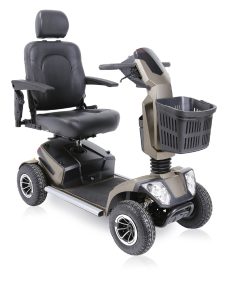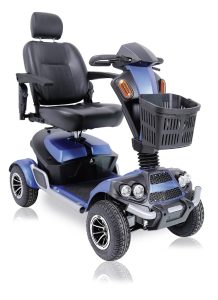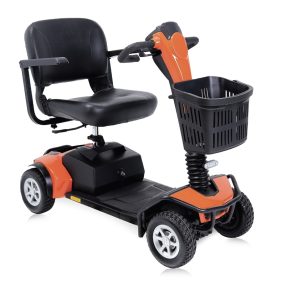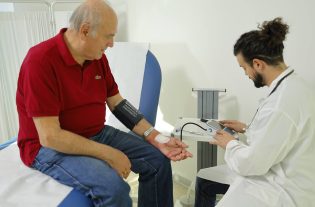Electric scooters represent an ideal solution to improve the independent mobility of the elderly and people with mobility impairments, offering them the freedom to move both in urban areas and in rural environments.
These vehicles allow users to move safely and independently, enabling them to face daily challenges with greater autonomy.
In this article, we will explore the features of electric scooters, what to know before getting behind the wheel, how to perform proper maintenance, and the traffic rules that apply to them.
Electric Scooters: key features
 Electric scooters for the elderly or people with reduced mobility are designed to facilitate movement for those with motor difficulties, with a structure designed to offer comfort, safety, and ease of use.
Electric scooters for the elderly or people with reduced mobility are designed to facilitate movement for those with motor difficulties, with a structure designed to offer comfort, safety, and ease of use.
Their speed, by law, does not exceed 15 km/h and they are suitable for traveling long distances, with an autonomy of up to 45 km. Some models are foldable, making transportation by car or public transport easier.
What do you need to know before getting behind the wheel?
Where can electric scooters circulate?
In Italy, the Road Code considers electric scooters as mobility aids, not motor vehicles, which means the circulation rules are less restrictive. Scooters can travel in pedestrian zones or on the edges of roads when sidewalks are insufficient or nonexistent and are not subject to the traffic bans in lanes reserved for motorized vehicles.
 Is a helmet, insurance, road tax, or inspection necessary?
Is a helmet, insurance, road tax, or inspection necessary?
To ride a four-wheeled electric scooter, it is not mandatory to have insurance, wear a helmet, pay a road tax, or undergo an inspection. However, it is recommended to have insurance coverage to protect against potential damage to third parties or accidents.
Do I need to be able to “drive”?
No special skills are required to use an electric scooter. The controls, which are generally simple and intuitive, allow for easy acceleration, braking, and steering. However, it is essential that the user becomes familiar with the scooter before using it in complex environments or on difficult terrain.
Electric Scooter Maintenance:
Regular maintenance is essential to ensure the proper functioning and safety of the scooter. Here is a summary of the key aspects to pay attention to:
 Battery:
Battery:
- Connect to the charger after each use and during inactivity to prolong its lifespan.
- Replace every 2-3 years or when autonomy significantly decreases.
Wheels and Brakes:
- Regularly check the wear on the wheels for stable driving.
- Check the efficiency of the brakes, especially in models with an electromagnetic brake system.
Motor and Electronic Components:
- Periodically inspect, even though brushless motors require minimal maintenance.
- Pay attention to vibrations or signs of wear that could affect performance.
Cleaning:
- Use a soft, dry cloth to clean the frame and surfaces.
- Avoid harsh cleaning products that could damage electronic components and the bodywork.
Additional Tip: After purchase, carefully store the user manual of your electric scooter. This document contains all the necessary information.
By following these simple guidelines, you can keep your electric scooter in excellent condition, ensuring safety and longevity.
Can scooters really improve the autonomy of people with mobility impairments?
Electric scooters for the elderly or people with mobility impairments are an effective solution to improve the autonomy of elderly people or those with mobility difficulties, allowing them to move freely and safely. Thanks to available tax benefits, these vehicles are becoming increasingly accessible and can be customized based on individual needs. By following circulation regulations and performing proper maintenance, electric scooters can truly improve quality of life, making daily travel easier and safer.










